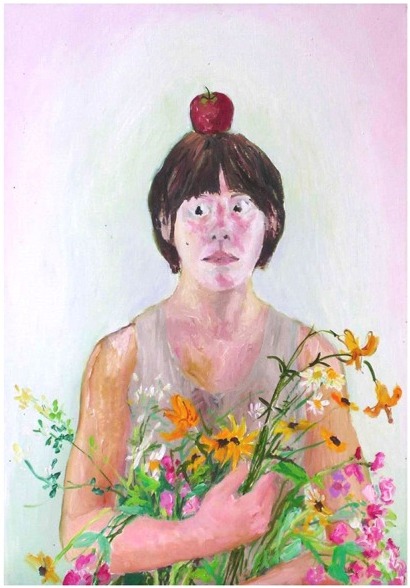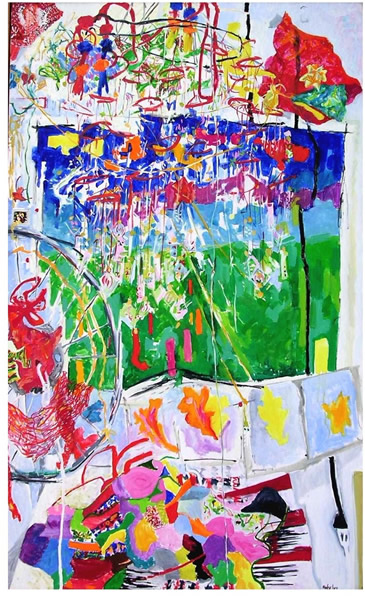|
|
| |
The
Performance is the Point
The performance is the point (Who cares?)
Who cares what gave it laughter?
All conscious men are slaves.
Even in my dreams when I find you there behind me
and turn to you, you never back away.
You're always so substantial there beneath your clothes
Breathing in and in and in
as your arms so softly encircle me.
And once again ordinary happenstance
and bumble bring delight.
To each in accordance with potential
Sweet potatoes crawled out of my chest
Something in the soup...
Light in the open air
|
 "Celeste" oil 20" x 28"
1975
"Celeste" oil 20" x 28"
1975 |
Celeste
There I was like an old old woman
stark ready to begin,
no obstructions ahead and nothing behind.
There was NOTHING in fact...
nothing but my earnestness.
Standing there with my arms full of wild flowers
plucked from my own forests, my earth
face aglow with an ancient fire.
Fire of Goya, fire of Celeste, fire of no name.
Foolish, this tender wild anticipation, tinged;
tinged always with nearliness.
Asking
without caution or hope.
No design, and with an apple on my head!
There like an antique stele, a Grecian urn, an Italian pun,
a lesson in posture..
Stonehenge, Momotaro
Froggy
frump
Of, resembling, pertaining to, or full of
fugio
I flee.
|

"Hysterical Space" oil 42"
x 70" 1976
|
Hysterical Space
I approached finding space so deeply in I plunged ... then, reaching
back in front,
my fear was coupled with affection, and never looking back.
Oh joy in paper, glass, and, string and also shiny metal,
color, form and time gone by, my current raw dilemma.
The corner held a window which fell away into a building block
of clean fresh space in playful shape and one-eyed-two-eyed vision
where colored clouds swung round themselves while strumps of paint
receded
and beckoned you to enter IN and mind those strings and things
flung forward now to slow you down (to scintillate and demonstrate)
(Defend, obscure and animate)
To bring to you this melody of chirp and whit and yarrow.
Wind bells make a mighty screen, and threads of multi-colors
lots of things to fill it out, I've laid it all before you,
and if you care to take a look it's now this painting's painted. |
|
"Hysterical Space"
is a meditation painting (1976). It was painted from a complex
still life constructed of made and found objects. These objects
included a "corner painting" -literally a warped canvas
painted with a simplified landscape, four painted studies of leaves,
a pastel still life on its side, a scarf, a bicycle wheel, a utility
light, colorful paper bags and other papers, yarn, strings and
lots of glass wind chimes. The use of made and collected objects
allowed the artist greater control and introspection or "introspection-compounded".
These objects become
short hand for whole ideas which include emotion, idea, impulse,
in the same way that a line of poetry speaks to us on many levels
and can be used in thinking to combine complex thought/feeling
events. The
act of painting, on the ot her
hand, was an exercise in "two-eyed" vision or parallax
such as was used by Cezanne in some of his landscapes, still lifes,
and especially the later watercolors. Cezanne's
brush strokes demonstrate his experience, his growing wisdom and
reveal a personality ever disappearing (and coming into being).
His attitude is also neutral, whether omission, inclusion, or
embellishment -that is, none-no embellishment, even his color
is "naturale". Cezanne's visual involvement was in fact,
the direct practice of Emptiness. He was dependant upon his subject,
committed to it, felt the space around and in the subject. In
short, Cezanne was in nirvana ever increasingly as an adept...through
the use of his eyes. The
"missing" paint strokes in his works set the still lives
or landscapes into motion, a motion also in our observing eyes.
Parallax. Ether. He pierces space itself, and, he tickles our
eyes! Cezanne's communing with the cosmos is preserved for us
in our eyes and in his paintings. He could not maintain these
experiences nor could he describe them, but he needed to achieve
"it" over and over. And though he could not control
the event, he did notice "it" and got to know "it"
more and more. Cezanne sends himself out repeatedly until he himself
is changed. Cezanne's lack of sentimentality and his devotion
to this vision (just like your vision or mine) are the force of
his art.
In
"Hysterical Space",the still life "substitutes"
for landscape/reality-subject and the color is far from natural;
in fact often color is the action itself. Holsclaw too plays with
the visual edge between form and appearance, space, parallax,
volume and light, revealing affection, humor and visual thinking.
The involvement (commitment without goal, effort...a kind of fearlessness)
is determined by the interaction between the seen still life and
the painter's vision, and, the unfolding painting. A refusal to
dominate, a deliriousness, openness, -"emptiness" applied
to phenomena and maintained. Thus, a meditation; a visual meditation.
|
|
Chagall
too uses meditation but from a different place. Chagall's imagery
is ordinary-people, animals, angels, clocks, towns, cities- ordinary,
important and surprising at once, and it is always presented to
us as narrative that takes place as we work our way around inside
his paintings. We are directed by the particulars of a changing
color scheme, the limitless range of placement, size disparities,
and by the unusual angular views. Chagall is inside his paintings
and inside his memory waging war (puttering) with the elements
or at least making connections and equations. His world is a charged
but reasonable universe. We may intimately see a foot and leg
as can only be seen from near and above (as his memory describes
it), or a milk maid upside down and equivalent to a man walking
right beside her but upright (a bargain). The lovers he paints
so often, perform acts of devotion over and over in their expanding
spheres of influence. Likewise, Chagall's color schemes have subsets
that we don't notice at first but which burst into view and overwhelm
us with surprise. In his "Christ paintings" his 'bargaining'
becomes obvious. Antagonist, protagonist, all the elements together
interact and this expands out to become one event. He leads us
through his constructions visually. He is the magician, and image-smith
and the good minister. He is expounding (law) -"dharma",
-Chagall's dharma. It is in the Judaic-Christian line just as
James Joyce, for instance, expounds 'his'- Joyce's dharma- but
by using a Catholic lens. Chagall's love of animals stands out,
and his regard for the Bible. Memory,content
and time- 'his' memory and 'our' time, the time in which we combine
his elements as we view his works. He is also of course, a suburb
artist visually, a colorist and a comedian and a poet. While Cezanne
looks directly into the heart of seeing, and shows us the emptiness
underneath shape, Chagall expounds visual memory and joy. These
are distinctions of thoughtful artists. Content. Visual content.
Personal content. Real content that could change your life. The
works exists for others and they say so. In "Hysterical Space"
too, we stroll around the painting. The illusion of depth is supported
by "suspended" leaves, other "things" and
"strumps" of paint that float out at us or even upwards.
Here depth is shorthand for past or intimacy or memory and spectator
space becomes future or present or event. However intimate the
work is, that intimateness can descend upon us, or, it may not.
Modern "compressed space" of abstract expressionism
is pushed away in favor of an airy jumble and ramble with space.
But how close is nirvana to the abyss? And why is the painting
called "Hysterical Space"? Well, it is because of the
intensity of not knowing, and because of intimacy, because of
visualness. |
 |
 |
|